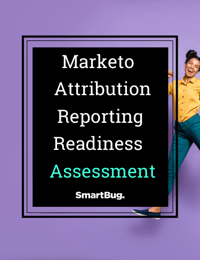
Bizible Reporting Tools Explained
December 15, 2020
Bizible is a marketing attribution software that tracks and reports on channel performance. This solution can provide visibility into which channels are driving the most engagement amongst your customers and prospects. This type of information is key for marketers to understand which channels are performing best, make informed decisions, and prove marketing ROI.
That all sounds great, right? But, what does that really mean? As we shared in a previous blog post, attribution reporting is about giving credit to your different marketing initiatives to see which channels are generating the most results. It helps you understand where leads are coming from, which content they are engaging with most, and what content is converting those leads.
Some marketers may be tracking attribution today, but they may not be getting the full picture. Two common forms of attribution reporting are first-touch and lead creation attribution. While these models help the marketer understand what generated the lead, this doesn’t pull together the full picture of the channels and content that influenced the person to convert into an opportunity or customer. A solution like Bizible can provide that full picture through multi-touch attribution.
Learn how Bizible tracks multi-touch attribution and the reporting tools available.
Types of Attribution Models
Bizible reporting tools utilize six attribution models to help you measure the success of your marketing efforts. Here is an overview of the model types:
- First touch: This model focuses on the very first interaction with a lead, and it credits attribution to the first time the lead interacted with your company.
- Lead creation: This attributes 100 percent of the credit to the source that motivated the prospect to provide their contact information and become a lead.
- U-shaped: This combines the first two models (first touch and lead creation), with each interaction receiving 50 percent of the revenue credit.
- W-shaped: This model adds in additional touchpoints, crediting first touch, lead creation, and opportunity creation. Thirty percent of the credit is distributed to all three of these touchpoints. The remaining 10 percent is distributed to any other interactions along the way.
- Full path: Similar to w-shaped, this credits first touch, lead creation, and opportunity creation, but layers in closed/won credit as well.
- Custom model: Bizible’s custom attribution model allows users to choose which touchpoints to track and control the percentage of attribution credited to each point.
The model that you use should depend on the data you want to report on. Regardless of the model, the revenue generated from any deals gets attributed back to the marketing touchpoints that drove the sale.
Now that you understand the attribution models, here is a breakdown of how the Bizible reporting tools work and what types of information you can extract with them.
Bizible Reporting Tools
Preparation
Before you are able to start building your reports and gathering insights, you must configure Bizible to gather key information. There are four main components that allow Bizible to track, organize, and share data, as well as provide reporting capabilities. These elements are:
- Bizible’s JavaScript
- Customer Relationship Management (CRM) Integrations (either Salesforce or Microsoft Dynamics)
- Third Party Applications/Systems, like Marketo (see the full list of applications here)
- Bizible Application
Bizible Reports
After these components are implemented and connected, you are ready to start tracking multi-touch attribution. Bizible provides a variety of dashboards and reports with their Discover product. Below is a breakdown of the types of Bizible reports available.
Dashboards:
- Cohort Journey: This dashboard provides a view of the progression from the first stage through the full funnel for a selected time frame. It includes conversion rates along the way.
- Passport: This dashboard presents leads, contacts and opportunities by pipeline stage during a given time frame.
- Snapshot: This dashboard provides a snapshot of CRM at any selected time, including the distribution of records across lead/contact and opportunity stages.
Reports:
- Revenue by Channel
- Closed Revenue
- Contacts Created
- Leads Created
- Opportunities Created
- Closed Deals
- Pipeline Revenue Generated
- Paid Search ROI
- Total Spend
Additional Reporting Tools
While Bizible provides out-of-the-box reports as part of the Discover offering, you may decide to purchase Bizible without this product. For reporting, you may also prefer to use your CRM or another tool all together. Regardless of the tool you choose, you are able to populate reports with Bizible multi-attribution data. Here is some helpful information for you in case this is the direction you wish to go.
CRM Reports
- Microsoft Dynamics: Build custom reports including campaign data, touchpoint information, lists, and more, or select from a variety of default dashboards and reports options.
- Salesforce: With Bizible, you can create standard Salesforce reports like Opportunities by Marketing Channel, Leads by Bizible touchpoint, and more, or you can create all new report types by pulling in Bizible data.
Data Warehouse
Through the use of Bizible’s Data Warehouse, you can take all of Bizible’s recorded data and present it the way you want it. The Data Warehouse allows you to connect to a business intelligence (BI) platform, like Tableau or Domo, to present the information for your organization. This provides you with more visual options than CRM reporting.
Now that you are more familiar with Bizible and the reporting tools available, does it sound like the right solution for your organization? Compare Bizible to other multi-touch attribution tools and decide.
Regardless of the attribution tool (or tools) you select, a multi-attribution tool will help you understand what is working and what is not, what content is most impactful for your customers and prospects, and prove marketing’s impact on revenue.

About the author
Danielle Langenderfer was formerly a Marketing Automation Manager based in Cleveland, OH. Dani provided Marketo expertise and support in everything from implementation through to strategy and execution. Outside of work, you can find Dani playing with her daughter, crafting, or cooking/baking. Read more articles by Danielle Langenderfer.







